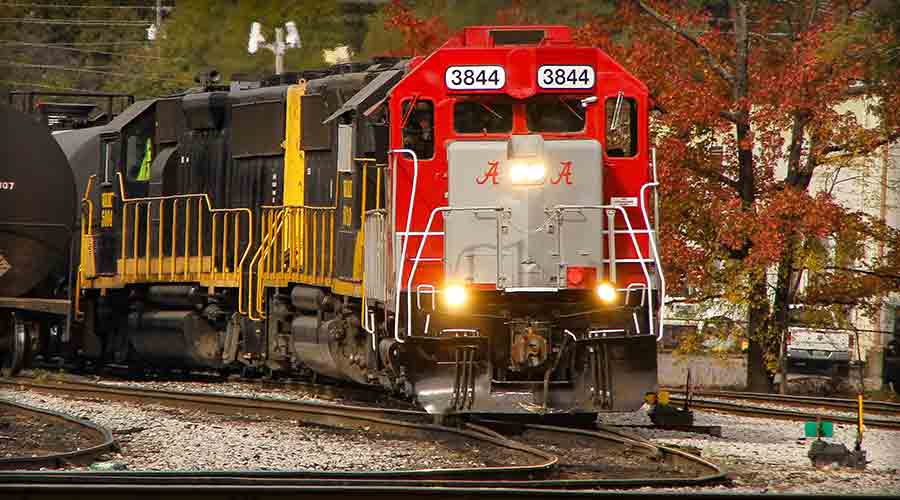Watco short line pursues another Alabama yard to keep pace with soaring traffic
6/6/2023
By Jeff Stagl, Managing Editor
Many U.S. railroads of all sizes are dealing with traffic declines this year. But the Alabama Southern Railroad (ABS) isn’t one of them.
The 97-mile short line is instead trying to manage explosive carload growth — as in a 17% year-over-year traffic gain so far in 2023.
Since 2012, ABS’ bridge traffic — or carloads received from one major railroad then handed off to another — has shot up 62%. Bridge traffic typically moves between the Northeast, Southeast, Southwest (predominantly Texas) and points in Mexico.
ABS’ line runs from Columbus, Mississippi, through Tuscaloosa, Alabama, to Brookwood, Alabama. The short line interchanges with Canadian Pacific Kansas City in Artesia, Mississippi; Norfolk Southern Railway in Tuscaloosa; and CSX in Brookwood.
Owned by Watco, ABS primarily transports products for the chemical, energy, grain, paper, roofing and steel industries. Currently, the railroad’s traffic is being driven by strong crude oil and steel markets, says Watco Sales Director Cody Gilliland.
For example, CPKC moves crude oil from a point in Canada to Artesia, where ABS interchanges the traffic and then transports it to a refinery in Tuscaloosa. That refinery has become a busy customer for the short line, which is registering strong growth with many online shippers, says Gilliland.
 Built in the early 1900s, Alabama Southern Railroad’s current yard can only hold 354 cars. The short line needs additional capacity to keep pace with explosive traffic growth. Watco/Mike Parker
Built in the early 1900s, Alabama Southern Railroad’s current yard can only hold 354 cars. The short line needs additional capacity to keep pace with explosive traffic growth. Watco/Mike ParkerFor all of 2023, ABS’ traffic is projected to climb 15% to 20% compared with 2022’s level.
“We are not seeing the softness seen by other railroads,” says Gilliland.
But to keep up with the gush of carloads, ABS needs to expand capacity. That’s why Watco and the short line soon will launch construction on a second yard in Tuscaloosa.
The $9.8 million yard will be built in the Tuscaloosa County Airport Industrial Park. Work is anticipated to start in July and conclude in third-quarter 2024.
“If we want to continue to grow, we need the infrastructure,” says ABS General Manager Cain Greene.
Under a first phase of development, the yard will feature two balloon tracks, each of which will be able to handle 60 rail cars. A balloon track guides a train in one direction, then around a circle and out in another direction.
The yard also will include a 2,000-square-foot administration building with offices, crew and locker rooms, showers and restrooms.
ABS’ current yard in downtown Tuscaloosa — which dates to the early 1900s — can hold 354 cars.
“Now if CSX has an issue or a washout, we get log-jammed and slammed,” says Greene. “Also, we don’t have a wye track or turntable to turn cars around. The locomotive wheels only go in one direction, so they get a certain wear.”
The new yard also will help decrease train traffic in the western part of Tuscaloosa, perhaps cutting motorists’ grade crossing delays in half, says Gilliland.
Moreover, the additional infrastructure will enable ABS to “hunt for new business” and reach new markets, he adds.
“Over the past number of years, we have not been able to market the short line to new customers because of the tight capacity,” says Gilliland.
But long before plans for the new yard firmed up, it took years to find the right site and gain a capital commitment from Watco. After several unfruitful years spent searching for an ideal property along ABS’ line, Watco and the short line teamed up with the Tuscaloosa County Economic Development Authority to locate a site. It took three years to find the ideal, level piece of property, says Gilliland.
The yard will be built on a 40-plus-acre site. About 10 acres will be left for future development if a large-scale industrial customer comes to the area and seeks rail service, says Greene. Currently, there are no firm plans in place for the yard’s second phase.
Tuscaloosa officials are embracing the yard project because rail shippers who expressed an interest in locating in the city in the past had to be turned away due to ABS’ operational constraints.
“If a large industry came here and wanted rail service, we had to say we are at capacity,” says Greene.


